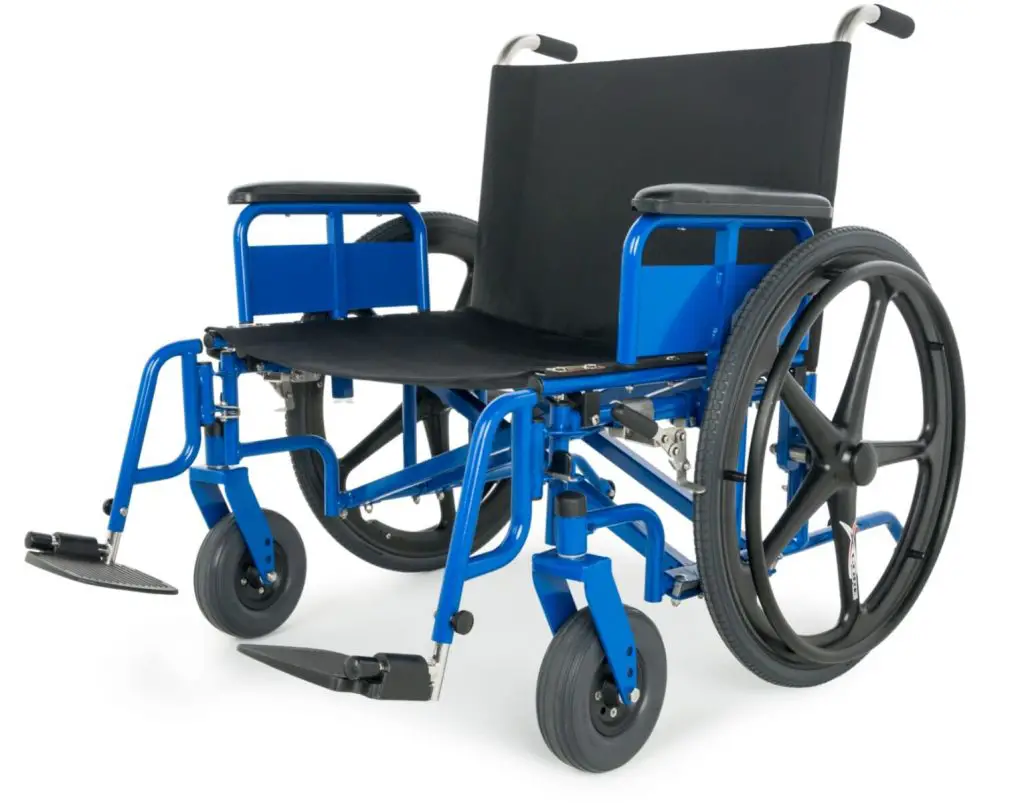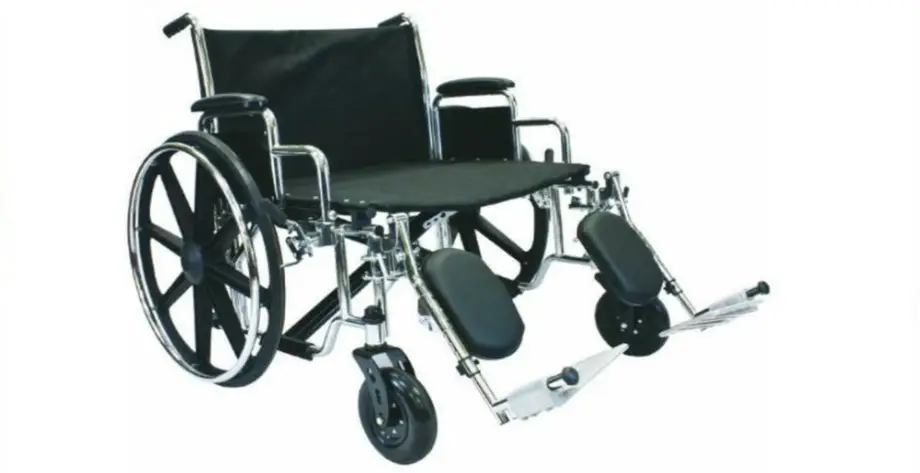Bariatric wheelchairs, also known as heavy-duty wheelchairs, are a special type of wheelchairs designed to bear the weight of obese persons.
Obese persons suffering from severe medical conditions such as stroke, osteoarthritis, muscular weakness, and cardiovascular diseases might have to rely on wheelchairs to move about.
Using the standard wheelchair might be dangerous. Not only will the wheelchair be likely to break down, but also the user may have to endure the discomfort that comes with using it. The need to solve these problems birthed the invention of the bariatric wheelchair.
The name is derived from the term “bariatric,” an area of medicine that focuses on the study and treatment of obesity.
To make bariatric wheelchairs more sturdy, they are made with materials quite different from that of standard wheelchairs (the common ones we see). Some materials and designs used in making bariatric wheelchairs are heavy-duty vinyl materials, steel, and reinforced cross braces.
These features make the bariatric wheelchair heavier than the standard wheelchair.
The bariatric wheelchair can weigh up to 100 pounds and can support obese persons weighing up to 900 pounds.
Table of Contents
- Features of a Bariatric Wheelchair
- Why You Need a Bariatric Wheelchair
- Guides to Help You Shop for a Suitable Bariatric Wheelchair
- Differences between Bariatric Wheelchairs and Bariatric Transport Chairs
Features of a Bariatric Wheelchair
1) Wide Seats
Bariatric wheelchairs have wider seats than the standard wheelchair. Their seats can measure up to 30 inches as their width, and a depth of up to 20 inches. The area of the seat differs according to desired specifications of the manufacturer and special requirements from the obese person. The seats are foldable and are made with tough materials.
2) High Strength
Bariatric wheelchairs are made from tough materials that can withstand the heavy weight of the user. The seat and backrest are reinforced with crossed braces to make it stronger, while the frames are made with steel and heavy-duty PVC tubes. The seat, backrest, armrest, and footrest are also padded with tough upholstery materials.
Related: How to Get a Wheelchair-Bound Person into a Car
3) Adjustable Components
A way of ensuring that the bariatric wheelchair suits people with different body sizes is by making the components easily adjustable. You can find bariatric wheelchairs with reclining backrests, adjustable armrests, and footrests.
The depth and angle of the seats can be adjusted, as well as the height and angle of the footrests. The depth of the wheelchair, in this case, is the horizontal length covered from the back of your buttock to where your knees bend.
4) Modified Rear Axle Position
A typical bariatric wheelchair has an axle at the rear side of the wheelchair. This axle is what connects the two back tires.
In standard wheelchairs, the rear axle is positioned in a way that allows most of the user’s weight to fall directly on the axle. However, for an obese person, most of the person’s weight will shift a bit forward than that of an average-weight person. This causes manufacturers to shift the rear axle a bit forward so that most of the user’s weight will rest directly on the axle.
The aim of ensuring that most of the user’s weight falls on the axle is to allow the user to easily wheel the wheelchair by themself.
5) Thick Tires
The tires of bariatric wheelchairs are usually thicker than those of standard wheelchairs. Without the thick tires, you might find it difficult to propel yourself, especially in rough paths. Thick tires will also be able to bear your weight without wearing out easily.
Related: How to Get a Wheelchair Up and Down Stairs (Complete Guide)
Why You Need a Bariatric Wheelchair

As an obese person, doing some activities in the home or workplace might become difficult as a result of your weight. It could be that you easily get fatigued when you walk or that you suffer from a disease that requires you to be in a relaxed position at all times.
While having these difficulties, you might have to buy a wheelchair to use as a mobility aid.
There are some reasons why you have to go for a bariatric wheelchair.
1) To Ensure Your Safety
Most standard wheelchairs put the weight limit of users at about 300 pounds. If you weigh above the weight limit of the wheelchair, you might be putting yourself at risk when you use it. Standard wheelchairs are made from steel and aluminum, which can’t support the weight of an obese person.
A bariatric wheelchair is what you need to maximize your safety.
2) To be Independent
Some obese persons mostly rely on assistance from friends and family members to carry out some basic activities. Having a bariatric wheelchair gives you a certain level of independence in your home. You will be able to move around your home easily.
Even at your workplace, you will be more swift and efficient. If you’re buoyant enough, you should consider buying a powered bariatric wheelchair, which is an automated version of the manual bariatric wheelchair.
3) To Manage Your Health
Some advice your doctor must have given you after being diagnosed with a disease is to get enough rest. Using a bariatric wheelchair to move about is a great step in achieving the needed rest. You can choose to stay in various comfortable positions while at work or home due to the adjustable nature of the bariatric wheelchair.
4) To Serve as a Carrier
Bariatric wheelchairs can be modified to make storage spaces for users who use oxygen tanks.
So, if you have a breathing problem that requires you to use oxygen tanks or any other medical equipment, a bariatric wheelchair will help ease your burden. Also, it will be easier putting your items in the pouch of your wheelchair than to deal with the stress of carrying them about in your hands.
Related: How to Transport a Power Wheelchair (Complete Guide)
Guides to Help You Shop for a Suitable Bariatric Wheelchair
If you’re about to purchase a bariatric wheelchair for the first time, you’re likely to be overwhelmed by the designs and styles put up for display at the wheelchair shop. You may end up with the wrong size or features you need if you don’t plan properly.
Follow the steps below to select a suitable one.
1) Consider the Seat’s Width and Depth
Bariatric wheelchairs are manufactured in various seat sizes. You must know your size before buying one. You can determine your size by sitting on a hard surface and having someone measure the length across your hips.
The length you get is the width of the seat to consider. The depth is the length of your thigh, starting from the back of your buttock to your knees.
Add a few inches to what you have measured after taking your measurement. The new measurement is to give more room to adjust yourself comfortably on your seat.
2) Check for Portability
Even though bariatric wheelchairs are generally heavier than standard wheelchairs, buying a relatively lighter one will make transportation with a vehicle easier. You should also ensure that the wheelchair is foldable and occupies minimal space.
3) Verify its Weight Capacity
You must confirm your weight before buying a bariatric wheelchair. Your weight will determine the model of wheelchair you should select. Check for the weight capacity of the wheelchair in the product’s manual. To be on the safe side, look for wheelchairs with a weight limit that’s higher than your actual weight in case you gain some weight later on.
4) Check for Strength of Tires
Ensure that the wheelchair you’re about to buy has solid or PU tires. These types of tires are recommended for a bariatric wheelchair.
5) Confirm its Adjustable Components
Bariatric wheelchairs usually have adjustable features like footrests, armrests, backrests, and seats. Ensure that the wheelchair you’re about to buy has these features and they can be adjusted to give you the comfort you desire.
Related: How to Clean & Disinfect Your Wheelchair Like a Pro
Differences between Bariatric Wheelchairs and Bariatric Transport Chairs

Bariatric wheelchairs and bariatric transport chairs share a lot of similarities and can easily be mistaken for one another. However, they have some obvious differences that you can use to differentiate them.
1) Weight
Bariatric transport chairs are lighter in weight than bariatric wheelchairs even though they have the same weight capacity. This is because the transport chairs are meant to be used at short intervals, unlike the wheelchairs. So, the transport chairs don’t have to be as sturdy as the wheelchairs.
2) Tires
Bariatric wheelchairs have two large rear tires, unlike the transport chairs whose rear tires are smaller. You can be able to propel yourself with the help of the large tires in a bariatric wheelchair. But a bariatric transport chair requires someone else to push you.
3) Size
You can tell the difference between a bariatric wheelchair and a bariatric transport chair from the sizes. Bariatric transport chairs are smaller and have lesser features than bariatric wheelchairs.
Despite the differences between them, they serve almost the same purpose. If you have nobody to push you around and you plan on sitting on a mobility aid for most of the day, then you should go for a bariatric wheelchair.



